Japanese airline All Nippon Airways (ANA) is to begin trials of driverless buses to transport passengers at Tokyo’s Haneda Airport as part of a goal to fully implement the autonomous technology by 2020.
The trial will see a passenger bus operate within a restricted area of the airport using Level 3 autonomy that works by following magnetic trackers embedded into the ground. Onboard sensors will enable the bus to guide its way around aircraft and cargo areas even if GPS signals are unavailable. The buses will also feature a safety system called ‘dispatcher’ that enables the operator to monitor progress including the interior and exterior of the bus in real time and take control when needed.
“At ANA, we are constantly striving to move the industry forward,” said Shigeru Hattori, senior vice president of ANA. “This autonomous bus will help ease the flow of traffic in the airport and help enhance the traveling experience for passengers. In addition to boosting convenience, the autonomous bus will also allow for safer travel within the airport and we will continue the tests until the technology reaches our high safety grade.”
ANA is conducting these trials with Aichi Steel, SB Drive Corp, Advanced Smart Mobility, Nippo Corporation and NEC Corporation. The trial is the second phase of testing of the self-driving vehicles following a run in February 2018, however this time it will see other Japanese airports including Narita, Sendai and Nagoya also perform trials with other companies.
The goal is to fully validate the self-driving buses so the airline will be able to roll out the buses on a larger scale by 2020 to create a more efficient service for travelers.
Pic credit: ANA_WEB


